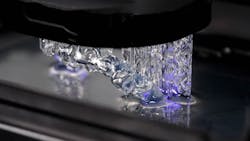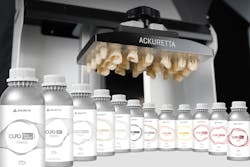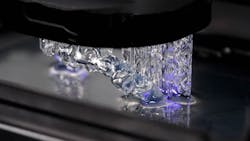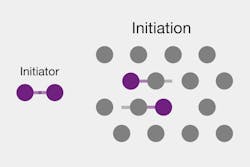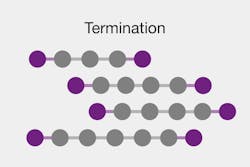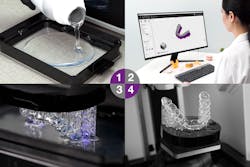How does resin polymerization work in dental 3D printing?
What you’ll learn about polymerization and dental 3D printing:
- What is 3D printing resin?
- What is polymerization in 3D printing?
- The ins and outs of postprocessing in digital dentistry
- Key takeaways
In today’s world of dentistry, it is almost impossible to remove the terms 3D printing and digital from the picture. Additive manufacturing—otherwise known as 3D printing—is revolutionizing the industry. Its speed, accuracy, and affordability make it an increasingly popular choice among dentists and lab technicians who want to prioritize these in their practice or laboratory. The Ackuretta SOL is just one example of a printer making printing easier, faster, and more accessible to everyone—whether it’s splints, surgical guides, dentures, or anything in between.
3D printing has been around for more than 40 years, but it has grown exponentially in the past 10 years and is projected to keep growing. Today there are roughly 230 dental 3D printers manufactured by more than 75 companies worldwide.1 The global dental 3D printing market is estimated at roughly $3.2 billion in revenue,2 and it is predicted to grow to $9.5 billion by 2027.3 This technology has revolutionized production spanning from the medical, dental, and aerospace industries to the culinary and automotive fields.
You may also be interested in … Trending Topics: 3D printing
While there are many different printing technologies on the market, those used in the digital dental field include stereolithography (SLA), digital light processing (DLP), and liquid crystal display (LCD) in both RGB and monochrome. All these methods use liquid resin as the material from which the prints are made. Through the process of polymerization, the resin is transformed from a liquid into a solid, and after postprocessing it results in a print that is both durable and biocompatible.
You may be familiar with the different steps in a digital workflow, but to learn more, take a look at the step-by-step process. The technology that turns liquid resin into a solid print is less well-known, but the innovation behind it is fascinating. To understand this process of polymerization, we need to know more about the resin material itself.
What is 3D printing resin?
Resin is a substance that can be produced either naturally or synthetically and is made up of different components depending on its use and function. It is the material used in 3D dental printing for everything from models to dentures to surgical guides. While simply known as “resin” or “material” in the 3D printing world, it can also be called polymer resin, resin-based composite (RBC), or photo-sensitive resin. The resins on the market are differentiated based on their composition, which is a combination of monomers, cross-linkers, fillers (for example, ceramics in the case of permanent resin), pigments, and other chemical components. These components and their proportional quantities determine the accuracy, printing performance, biocompatibility, mechanical properties, and other elements of the final print you’re trying to achieve. All dental 3D printing resins (and photopolymer resins in general) should have at the minimum a monomer4 (which is the main component), a cross-linker, and a photoinitiator (which reacts when it comes into contact with UV light).
Prior to composite resins, other materials were used in dental applications, especially as they pertained to fillings: gold, then concrete, and dental amalgam.5 The 1950s and ’60s saw the formulation of the first composite resins and appearance of the term “composite” in dentistry, which was previously known as “reinforced.”
You may also be interested in … Pros and cons of dental 3D printing, from a dental tech
The range of resins available on the market is growing all the time, and this is where the potential of 3D printing lies. The number of applications that can be printed is expanding. Companies are currently working on creating a resin to print reliable aligners in-house, which would be a game changer for the industry—and the speed at which it can be done is also increasing. It is possible to print a crown and have it in your patient’s mouth within an hour.
Polymerization is the next step.
What is polymerization in 3D printing?
Polymerization is the chemical process of turning resin from a liquid into a solid, through the formation of chemical bonds between the resin molecules. During printing, a vat of photopolymer resin is placed in front of a UV light source (an LCD screen, for example). The monochrome (or in some cases RGB) LCD screen allows the UV light to be emitted in a specific pattern; the resin only cures in the specific areas that come into contact with the light. Each layer is printed in the specific pattern in which light is emitted.
3 phases of polymerization
The process of polymerization happens in three phases: initiation, propagation, and termination.
In the initiation phase, a catalyst (in this case, UV light) starts a reaction with the photoinitiator, which releases a free radical. Photoinitiators release these free radicals upon specific wavelengths of that light source. This is what starts the process of polymerization.
The free radical bonds with a monomer and opens the double bond, which begins a chain reaction. One monomer’s double bond opens, which then bonds with another monomer opening its double bond, which bonds with another monomer, and so on. This process is known as the propagation phase. More monomers become bonded together, creating long chains of molecules called polymers.
The termination phase occurs when two long chains—each with an open monomer on one end—bond together, forming one long chain. In other words, when the last free radical on one chain meets the last free radical on another chain, they combine, and the process is finished. This long polymer chain is one of many that make up the solid print.
Note: In 3D printing with an LCD screen (like the Ackuretta SOL and DENTIQ), the resolution of the print is determined by the size of a single pixel. In SLA (with a laser), the laser size determines that definition. DLP resolution is based on the definition of the projected image. Additionally, higher resolution does not equal longer printing time.
Polymerization process
- Liquid resin is poured into the vat or
- A 3D model is created using CAD software, and then sliced into multiple layers using software such as ALPHA AI.
- The 3D printer uses UV light via an LCD screen or laser to selectively cure the resin in the pattern corresponding to each layer of the 3D design.
- The build platform is lowered and then raised as each layer is cured, allowing the next layer of liquid resin to be exposed and cured on top of the previous
- This process is repeated for each layer of the 3D print until the entire product is
The result of this photopolymerization process is a solid object made of cured resin, which then must go through postprocessing to ensure that it’s fully cured and biocompatible. This is especially important for applications that will be in the patient’s mouth for an extended time, such as splints, crowns, and dentures.
Ins and outs of postprocessing in digital dentistry
Once your print is finished printing, the postprocessing steps ensure that the print is fully cured and safe for your patient.
Cleaning: The cleaning step—which is done with either ethyl alcohol or isopropyl alcohol (IPA)—removes any uncured resin from the print and any polymers that are cured but not fixed to the print. While cleaning is not part of the polymerization process, it is a necessary step in delivering a safe, high-quality final result to the patient or clinician. A dual-tank cleaning unit (such as CLEANI) is an ideal tool for this step.
Curing: Curing is the final step in the process that is performed with the help of a UV curing oven (such as the CURIE or CURIE Plus). This ensures that all the expected polymerizations are complete.6 Overcuring could occur if there is an excessive amount of reacting, which may cause more polymerization reactions, cross-linking reactions, or adverse side reactions than desired.
Once your print has been cleaned of all uncured resin, place it into a curing oven with UVs of different wavelengths, so they can penetrate the print and complete the polymerization process, ensuring safety and full mechanical properties.
After this step is completed, your print is finished and ready for your patient.
Key takeaways
- Resin is made up of photoinitiators, monomers, cross-linkers, fillers, pigments, and other chemical components.
- There are three phases in polymerization: initiation, propagation, and
- Postprocessing is essential to ensure your print is both durable and
Definitions
- Monomers: small organic molecules that can form a repeating pattern when covalently bonded to one another.
- Polymers: big molecules made up of smaller monomer units that are covalently bonded in a repeating pattern.
- Polymerization: a process whereby a large number of monomer molecules react together to form a polymer.
Editor’s note: This article first appeared in Through the Loupes newsletter, a publication of the Endeavor Business Media Dental Group. Read more articles and subscribe to Through the Loupes.
References
- Global Dental 3D Printing Sky Research Forecast. https://skyresearchforecast.com/reports/medical-devices
- Dental 3D Printing MarketsandMarkets. https://www.marketsandmarkets.com/Market-Reports/dental-3d-printing-market-258228239.html
- 3D printing: the future of dentistry. Burkhart Dental https://www.burkhartdental.com/3d-printing-the-future-of-dentistry/
- 3D printing resins portfolio by Ackuretta. Ackuretta. https://ackuretta.com/collections/curo-resins-for-dental-3d-printer
- Riva YR, Rahman SF. Dental composite resin: a review. AIP Conf Proc. 2019;2193:020011. doi:1063/1.5139331
Additional resources
- Polymers in dentistry: dental composite resin. University of York Macromolecule Project. YouTube. April 23, 2014. https://www.youtube.com/watch?v=QtjgtqWYS_g
- Bowen RL. Properties of a silica-reinforced polymer for dental restorations. J Am Dent Assoc. 2013;144(8). https://els-jbs-prod-cdn.jbs.elsevierhealth.com/pb/assets/raw/Health%20Advance/journals/adaj/augustCentennialcommentary.pdf
- Resin polymerization. Mindspan Agency PR. YouTube. November 18, 2010. https://www.youtube.com/watch?v=Bc-LPYuggaw
- Polymers: crash course chemistry #45. Crash Course Kids. YouTube. January 6, 2014. https://www.youtube.com/watch?v=rHxxLYzJ8Sw
- Free radical polymerization. Animation (IQOG–CSIC). CanalDivulgación. November 24, 2016. https://www.youtube.com/watch?v=HpPHN7fcLHI
About the Author
Ackuretta’s Editorial Team
Ackuretta is a manufacturer of high-precision 3D printing solutions for dental professionals. Their best-in-class turnkey solutions bring the transformative potential of same-day dentistry to clinicians and lab technicians. Ackuretta’s 3D Printing Solution is a reliable, accurate, and validated system that delivers intuitive biocompatible workflows, outstanding customer support, and streamlined operations. Visit their website for more information.
Updated September 27, 2023
